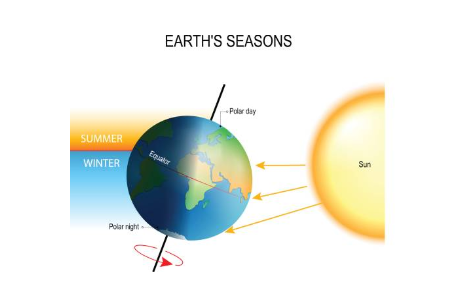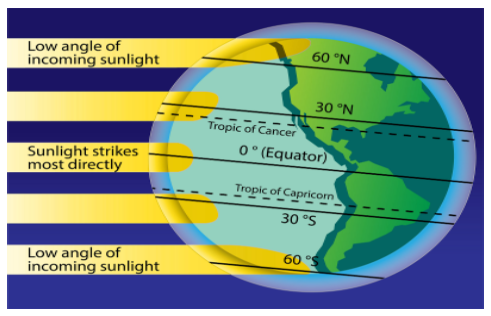- Earth's heat balance or budget is vital in maintaining a relatively constant overall temperature.
- The equilibrium is attained when the amount of solar energy received, known as insolation, equals the quantity of heat lost by the Earth through terrestrial radiation.
- Insolation denotes the solar radiation reaching the Earth's surface, mostly in the form of short wavelengths.
- This balance between incoming solar radiation and the energy released from the Earth as terrestrial radiation helps regulate the planet's overall temperature.
INSOLATION
- Insolation is the solar radiation received by the Earth's surface, and it's crucial for maintaining the planet's temperature.
- This incoming solar energy is absorbed by the Earth, which then radiates a portion back into space through terrestrial radiation.
- The Earth's heat budget is the equilibrium established when the absorbed incoming solar radiation equals the energy radiated back into space, maintaining a relatively constant temperature on Earth.
FACTORS CONTROLLING INSOLATION
1. ROTATION OF EARTH ON ITS AXIS
- The Earth rotates on its axis, which is tilted at an angle of approximately 23.5 degrees with respect to the plane of its orbit around the Sun.
- This axial tilt significantly influences the amount of solar energy received at various latitudes, creating the changing seasons and affecting the distribution of insolation on the Earth's surface.

2. ANGLE OF INCIDENCE OF SUN'S RAY
- The angle at which the sun's rays strike the Earth's surface varies with the latitude of a particular location.
- Higher latitudes receive sunlight at a shallower angle compared to lower latitudes.
- When the sun's rays hit the Earth's surface at a lower angle, they cover a larger area and the energy they carry gets distributed over a greater area, resulting in a decrease in the net energy received per unit area.
- Additionally, rays with a smaller angle of incidence travel through more layers of the atmosphere compared to rays striking directly, impacting the energy received at the surface.

3. LENGTH OF DAY
- The duration of the day plays a significant role in determining the amount of insolation received at the Earth's surface.
- Generally, longer durations of daylight result in a greater amount of insolation received.
- On the contrary, shorter daylight periods mean the surface receives less insolation.
4. TRANSPARENCY OF ATMOSPHERE
- The atmosphere's transparency is influenced by factors such as cloud cover, its density, dust particles, and water vapour.
- These elements can either reflect, absorb, or allow solar radiation to pass through.
- When thick clouds obscure the sky, they obstruct solar radiation from reaching the Earth's surface. Likewise, water vapour's absorption of solar radiation results in less insolation reaching the surface.
IMPORTANT: The areas that receive the highest insolation levels are the subtropical deserts, primarily due to their minimal cloud coverage. Comparatively, the equatorial regions receive less insolation than the tropics. Typically, within the same latitudinal band, insolation is greater over continents than oceans. During winter, the middle and higher latitudes receive less solar radiation compared to the summer season.
HEATING OF ATMOSPHERE
1. TERRESTRIAL RADIATION
- Before delving into terrestrial radiation, it's important to recognize several key facts about radiation:
- All objects, whether hot or cold, continuously emit radiant energy.
- Hotter objects emit more energy per unit area than colder objects.
- The temperature of an object inversely determines the wavelength of radiation; the hotter the object, the shorter the wavelength.
- As the Earth's surface is heated by incoming solar radiation (in the form of short waves), it transforms into a radiating body.
- Consequently, the Earth's surface radiates energy into the atmosphere, primarily in the form of long waves, which we refer to as terrestrial radiation.
- This emission of energy has a warming effect on the atmosphere, starting from the lower levels and extending upward.
- It's crucial to note that the atmosphere allows shortwave solar radiation to pass through but acts as an obstacle to longwave terrestrial radiation.
- Longwave radiation, notably in the form of heat, is absorbed by atmospheric gases, particularly greenhouse gases like carbon dioxide.
- This process indirectly contributes to heating the atmosphere.
- Subsequently, the atmosphere transmits this accumulated heat back into space. In this equilibrium, the total heat received from the Sun is effectively balanced and returned to space, ultimately maintaining a stable temperature at both the Earth's surface and within the atmosphere.
2. CONDUCTION
- Conduction is a mechanism of heat transfer that occurs when a warmer object comes into contact with a cooler object, allowing the heat energy to flow from the warmer object to the cooler one.
- This transfer continues until both objects reach the same temperature or the contact between them is interrupted.
- conduction takes place at the boundary where the atmosphere and the Earth's surface meet. This process is significant in heating the lower layers of the atmosphere.
- As the atmosphere directly interacts with the Earth's surface, conduction plays a role in the exchange of thermal energy between the ground and the air above it.
3. CONVECTION
- Convection is the process of heat transfer through the movement of a substance or mass, typically in a vertical direction.
- When the lower layers of the atmosphere are heated, either by the Earth's radiation or by conduction, the air becomes warmer and subsequently expands.
- This expansion results in reduced air density, causing it to rise.
- The continuous upward movement of heated air creates an area of lower pressure in the lower layers of the atmosphere.
- This situation leads to the downward movement of cooler air, as it moves to fill the resulting void, thereby initiating convection.
- This cyclical movement associated with the conventional process in the atmosphere allows for the transfer of heat from lower to upper layers, effectively warming the atmosphere.
- Convection primarily occurs within the troposphere, which is the lowest layer of the Earth's atmosphere.
4. ADVECTION
- Advection refers to the transfer of heat through the horizontal movement of air, commonly known as wind.
- Winds transport the temperature of one area to another. For instance, if a location is in the path of winds coming from warmer regions, its temperature will rise.
- Conversely, if the area is in the path of winds originating from colder regions, the temperature will drop.
Horizontal movement of air, or advection, is relatively more influential than vertical movement.
- In the mid-latitudes, a majority of the daily variations in weather (during day and night) are primarily caused by advection.
- In tropical regions, particularly in northern India during the summer season, local winds known as 'Loo' are a consequence of the advection process.
- These winds play a significant role in the temperature changes experienced in the region.
HEAT BUDGET
A heat budget, also referred to as the Earth's energy balance, describes the equilibrium between the incoming heat absorbed by the planet and the outgoing heat radiated back into space. Should this balance be disrupted, it would result in either a gradual increase or decrease in the Earth's temperature over time.
MECHANISM
- The insolation, or incoming solar radiation, that reaches the top of the Earth's atmosphere is considered 100%.
- As this energy passes through the atmosphere, a portion of it is reflected, scattered, and absorbed before reaching the Earth's surface.
- Out of this initial isolation:
- Approximately 35 units are reflected back into space. This reflection consists of 27 units from the upper regions of clouds and 2 units from snow and ice-covered areas, contributing to the Earth's albedo – the reflectivity of radiation.
- The Earth's surface absorbs the remaining 65 units of insolation. Within this, 14 units are absorbed by the atmosphere, and the Earth radiates 51 units back into space in the form of terrestrial radiation.

FAQs on Insolation and Heat Budget
1. What is Insolation?
Ans. Insolation refers to the incoming solar radiation received by the Earth. It's the energy emitted by the Sun and reaches the Earth's surface.
2. How is the Insolation's Energy Distributed?
Ans. The insolation arriving at the Earth's atmosphere is partly reflected, scattered, and absorbed. Only a portion reaches the Earth's surface, influencing the planet's energy budget.
3. What is Albedo and How Does it Affect Insolation?
Ans. Albedo is the measure of the Earth's reflectivity. Surfaces like clouds, ice, and snow reflect varying amounts of solar radiation. Higher albedo leads to more reflection and less absorption.
4. What Does the Earth's Heat Budget Represent?
Ans. The Earth's heat budget is the balance between the incoming solar energy and the outgoing terrestrial radiation. It maintains the planet's temperature equilibrium.
5. How is Earth's Energy Budget Maintained?
Ans. The energy budget is sustained by the distribution of absorbed solar energy, which is later released as terrestrial radiation, ensuring an overall equilibrium of energy in the Earth-atmosphere system.
6. How is the Insolation Process Vital for Climate and Weather?
Ans. Insolation plays a crucial role in establishing temperature patterns, climate zones, weather changes, and various atmospheric processes, ultimately influencing the Earth's climate and weather dynamics.
7. Can Insolation Affect Environmental Factors?
Ans. Yes, variations in insolation influence ecosystems, precipitation patterns, ocean currents, and atmospheric circulation, thereby impacting environmental and climatic conditions.
8. Is the Earth's Heat Budget Constant?
Ans. A stable heat budget maintains a constant temperature. When this balance is disrupted, changes in global temperature, such as global warming or cooling, may occur.
9. How Does Insolation Impact Human Activities?
Ans. Insolation has a significant impact on agriculture, energy production, and human lifestyle. Changes in the distribution of solar radiation can affect these activities.
10. How Do Scientists Monitor Insolation and Heat Budget Changes?
Ans. Researchers use satellites, ground-based sensors, and climate models to monitor insolation and heat budget changes, contributing to understanding climate dynamics and predicting future trends.

